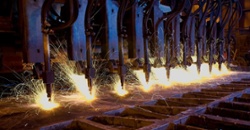
Constructing Your Smart Supply Chain Network
February 23, 2018
 Construction equipment manufacturers, just as Original Equipment Manufacturers (OEMs) in other industries, can be susceptible to the structure of their supply chain network. Both complex and simple supply chains, across large and small OEMs, can be negatively impacted without the right plan in place.
Construction equipment manufacturers, just as Original Equipment Manufacturers (OEMs) in other industries, can be susceptible to the structure of their supply chain network. Both complex and simple supply chains, across large and small OEMs, can be negatively impacted without the right plan in place.
The Risk Is Great
For larger OEMs, more rigid supply chain processes can be a hindrance to the growth of the organization. Shifting projects to another supplier can be a time-consuming and labor-intensive execution, while the evaluation of a new supplier altogether can take years for teams to develop RFQs and review responses, attend multiple plant tours, conduct ongoing audits, collaborate during the Production Part Approval Process (PPAP) and so on.
Even after work has been awarded, breakdowns can still occur in communication, priorities and standards across so many OEM teams and their many supplier contacts. This can result in the deterioration of quality, fair cost agreements, services and on-time delivery. For smaller OEMs, a lack of a formalized supply chain network can disrupt existing business, impacting production, sales revenues and brand good will, as well as inhibit their ability to take on greater demand.
Give Your Priorities Priority
With these risks in mind, construction OEMs can take steps to rank their organizational priorities and build a supply chain network around these specific priorities. Say your company is looking to decrease overall resources and costs associated with supplier management while reducing risk and markups, without interrupting existing quality and delivery criteria. The development of supply chain fabrication partnerships over transactional supplier relationships may be the preference, in this instance.
The consolidation (or the addition) of suppliers to a few select partnerships is a delicate balance. On the one hand, construction OEMs can experience vulnerabilities if the fabrication partner network is not properly qualified and managed over time.
On the other hand, OEMs can reap major benefits by streamlining their partner network. Supply stabilization, the minimization of warranty claims, near or total elimination of disruptions, reductions in wasteful spending through VA/VE, logistics and order management optimization – these are just some of the gains that may be realized through such a supply chain system. But how can OEMs achieve this balance?
The Importance Of Culture
It all comes down to a careful vetting process combined with habitual communications. Too often construction OEMs scrutinize partners initially, only to drop outreach until issues arise. This reactive method allows for the buildup of bad behaviors on the supply side while the OEM incurs the consequence.
Although communication can be viewed as a “soft cost,” it can have a swift and weighty impact. OEMs can divert potential problems by identifying specific rates (i.e., finished product first-pass quality yield, on-time delivery rate) and other information, as well as gathering a cultural understanding from each fabrication partner, by asking questions such as:
- What are the core values of your organization? How are these exemplified throughout the business? It’s easy to lay claim to a mission statement; it’s quite a feat to embed the mission into each facet of the company. Learn how your fabrication partner is making progress.
- How are notes and other account information stored and shared across personnel? Is an ERP and CRM in place and actively used throughout the organization? Systems that sit on the proverbial shelf without user buy-in may still mean your data is restricted to one or a small number of individuals. This is risky as your fabrication partner undergoes turnover.
- How are responsibilities distributed and managed? Risk increases if finite staff are routinely burdened or poor oversight exists.
- What is the leadership succession plan? A leading fabrication partner should have a solid management team in place to keep the operation running along should new leadership need to be sourced.
Ongoing communications should revolve around the current goals and objectives of your business as well as that of your partner; positive and negative performance reviews; and any updates/changes. In addition, plant visits should be conducted every six months, while full audits, regardless of performance, should be completed every three years.
While it may be daunting for some construction OEMs, it is possible to rely on fewer fabrication partners, reduce risk and command a multitude of benefits.